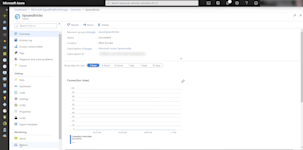Azure SignalR Service vs Breeze
This Azure SignalR Service vs Breeze comparison was created based on reviews from developers and our best attempts to perform analysis by looking at documentation and other publicly available resources.
Easily build complete, trusted realtime functionality.
Take our APIs for a spin Azure SignalR Service |  Breeze | |
|---|---|---|
| Getting started and developer experience | ||
Time to "hello world" Reviewed by 3+ independent developers Ratings were given based on the average amount of time it takes to sign up to a new account and publish the first message. | 4 / 5 5 = <30 min | 3 / 5 5 = <30 min |
Demos / Tutorials A selection of online demos and tutorials so you can test and see the code in action. Explore Ably's tutorials for our pub/sub messaging platform | ||
Documentation Reviewed by 3+ independent developers Explore Ably's documentation for our pub/sub messaging platform | 3.67 / 5 Getting started guides / 5 Information architecture and developer journey / 5 API reference documentation / 5 Readability, design and navigation / 5 Quality of code / 5 Breadth and quality of tutorials / 5 “The existing documentation is largely OK, most things are explained clearly, and the information is structured logically. Sometimes you may come across pages that were clearly written fast, so the quality of writing may not always be great. There are quickstarts in about seven languages, which is always nice to see, and there’s a diversity of handy how-to guides. Now, for the less positive things. First of all, the API reference seems to be a relatively short page on GitHub and nothing more. Secondly, there are only two tutorials embedded in the docs - and they both focus on building a chat room. More tutorials and more use cases, please! The UI is minimalistic. While sometimes this is a good thing, in this case, it just makes the SignalR documentation (and indeed the product) look and feel like an unimportant or second-hand solution.” | 4 / 5 Getting started guides / 5 Information architecture and developer journey / 5 API reference documentation / 5 Readability, design and navigation / 5 Quality of code / 5 Breadth and quality of tutorials / 5 The Breeze documentation is detailed and clear with examples and links to source code. The docs feature a ‘Get Started’ section where you can learn how Breeze works, discover more features, and read the FAQ. The Getting Started guide is well-structured to provide step-by-step guidance on how to set up Breeze and use the APIs, learn how Breeze works, try the Breeze live tutorial, discover features, learn about deploying apps to mobile devices, read the FAQs, and guide you through some of Breeze’s basic capabilities with an emphasis on querying data. There’s the "Breeze Live Tutorial" which is a quick way to learn basic Breeze interactively – follow the instruction, type in some code, and see the results immediately. The live tutorial page features four (4) panes, consisting of the instruction panel, JavaScript and HTML panels, and Output panel. There’s an extensive API reference and comprehensive individual release notes for each Breeze technology (chat & server). However, although Breeze is well documented, the developer journey is not straightforward because each Breeze JavaScript library – Angular, Aurelia, Knockout, Backbone, etc. – requires a different setup for its promise and AJAX implementation. API reference documentation is not detailed and seems to only exist on GitHub and be relatively short. The readability and design are mostly good, but they could benefit from a revamp. There’s no demo embedded in the doc. |
Dashboard or dev console Reviewed by 3+ independent developers Sign up for free and explore Ably's pub/sub messaging platform | 4.33 / 5 Ease of use / 5 Stats and reports / 5 Functionality / 5  “The Azure portal is intuitive and pretty easy to use. It provides diverse functionality that allows you to view, create, and manage all the resources you need, such as SingalR instances and connection keys. Among other things, you can also control IAM roles, set up integrations and alerts, and view various logs and metrics, such as the number of connections. More contextual help such as tooltips would be nice, as it’s sometimes unclear what some settings can do." | 4.33 / 5 Ease of use / 5 Stats and reports / 5 Functionality / 5  N/A |
SDKs Note: Only official SDKs were taken into account. Explore Ably's 25+ SDKs for our pub/sub messaging platform | 4 SDKs Including:
| 5 SDKs Including:
|
API structure Reviewed by 3+ independent developers | 4 / 5 API consistency across SDKs / 5 Well structured / 5 Intuitive / 5 Simple / 5 “The API structure is decently consistent, intuitive, and simple across most SDKs. The Python SDK is a bit obscure, especially when you want to make use of Azure Functions. The entire API reference documentation seems to be available only on GitHub (perhaps not the best platform), and there’s not much API documentation in general. There is a Swagger spec, though, which makes testing the API easier.” | 3.50 / 5 API consistency across SDKs / 5 Well structured / 5 Intuitive / 5 Simple / 5 Breeze APIs are consistent across SDKs – same order of operations. The API references are well documented, structured, detailed and extensive – there are examples for some SDKs on GitHub which is a nice thing. However, Breeze APIs are quite complex, so you need to thoroughly study the documentation to learn your way around it. |
 Azure SignalR Service |  Breeze |
|---|---|
| "Hello world" code example | |
| |
 Azure SignalR Service |  Breeze | |
|---|---|---|
| Realtime features | ||
Pub/Sub messaging Pub/Sub is a design pattern that lets any number of publishers (producers) push messages to channels (also known as topics). Multiple subscribers (consumers) can subscribe to a channel to consume published messages. Explore Ably's pub/sub messaging implementation | Limited You can use Azure SignalR in combination with backplanes such as Redis or Event Grid, which support the pub/sub model. Azure SignalR service is essentially a proxy for client-server communication and does not provide pub/sub capabilities by itself. | |
Message queues A message queue is a form of asynchronous service-to-service communication. Messages are stored on a queue until they are processed. Note that each message is only consumed by one subscriber (consumer). Explore Ably's message queues implementation | ||
Presence Presence enables you to track the online and offline status of devices and end-users in real time and to store their state. Essential for chat apps and multiplayer games. Explore Ably's presence implementation | ||
Message history Message history provides a means to retrieve previously published messages. For this to be possible, message data must be stored (persisted) somewhere. Explore Ably's message history implementation | Unknown | |
Connection state recovery (stream resume) In the case of unreliable network conditions, clients may suddenly disconnect.Connection state recovery ensures that when they reconnect, the data stream resumes exactly where it left off. Explore Ably' s connection state recovery implementation | ||
Guaranteed message ordering Ordering ensures that messages are delivered to consumers in the same order that producers publish them. Explore Ably' s guaranteed message ordering implementation | Limited There’s EntityManager.saveChanges that you can call multiple times to force Breeze to save a set of entities in the backend database in the same order as they appear. | |
Exactly-once semantics Exactly-once is a system-wide data integrity guarantee that ensures each message is delivered to consumers exactly-once. Explore Ably' s idempotent publishing implementation | ||
Message delta compression Message delta compression enables you to only send the changes from the previous message to subscribers each time there’s an update, instead of the entire message. Useful for use cases where there is a significant degree of similarity between successive messages. Explore Ably' s message delta compression implementation | ||
Native push notifications Native push notifications can be used to deliver messages even when clients are offline. Useful for geolocation updates or news alerts. Explore Ably's push notifications implementation | ||
Webhooks Webhooks provide a mechanism to get messages and other types of events (such as clients entering or leaving channels) pushed to your servers over HTTP. Explore Ably's webhooks implementation | Limited You can send webhooks to Azure SignalR Service via bindings for Azure Functions. However, SignalR Service can only consume webhooks, but it cannot send webhooks to other systems. | |
Serverless functions A serverless function is essentially an isolated, single-purpose piece of code that is only executed when it’ triggered by an event. For example, you can use serverless functions to send a welcome message to clients when they become present on chat channels. Note that serverless functions are usually fully managed by cloud vendors. Explore Ably's serverless functions implementation | Limited Can only trigger Azure Functions. Azure SignalR Service doesn’t have in-built support for other serverless platforms, such as AWS Lambda or Google Cloud Functions. | |
Built-in integrations Which popular services & systems are Azure SignalR Service and Breeze integrated with? Explore Ably's library of integrations | Webhooks
Serverless functions
Streaming
| Webhooks
Serverless functions
Streaming
|
Known limits and constraints Find out practical limits, such as the maximum message size, or the maximum number of concurrent connections. Explore the practical limits of the Ably pub/sub messaging platform | Throughput Unknown Maximum message size No size limit. Large messages are split into smaller chunks (max 2 KB), transmitted separately, and reassembled on the consumer side. Maximum number of units 100 SignalR Service units (sub-instances) per instance (applies to the Standard tier). Maximum number of concurrent connections 1000/unit (applies to the Standard tier) | Publisher throughput Unknown Maximum message size Unknown Maximum number of topics Unknown Maximum number of connections Unknown |
| Supported development platforms, languages, open protocols and cloud models | ||
|---|---|---|
Development platforms & operating systems Which popular development platforms and operating systems do Azure SignalR Service and Breeze support via official SDKs? Explore the development platforms supported by Ably |
|
|
Languages Which popular programming languages do Azure SignalR Service and Breeze support via offical SDKs? Explore the programming languages supported by Ably |
|
|
Open protocols Which popular open protocols do Azure SignalR Service and Breeze support? Explore the open protocols supported by Ably |
|
|
Cloud models Which popular cloud models do Azure SignalR Service and Breeze support? |
|
|
| Global and reliable edge service | ||
|---|---|---|
Edge messaging network with latency-based routing Latency-based routing ensures that clients are always routed to the nearest datacenter and point of presence. Explore Ably's routing mechanism that mitigates network and DNS issues | ||
Multi-region data replication (message durability) Multi-region data replication (storage) protects against single points of failure and ensures message data durability. Learn how Ably ensures message durability | ||
Uptime SLAs Here’s what the most common SLAs amount to in terms of downtime over a calendar year: 99.999% SLA = 5m 15s downtime per year 99.99% SLA = 52m 35s downtime per year 99.95% SLA = 4h 22m 58s downtime per year 99.9% SLA = 8h 45m 56s downtime per year 99% SLA = 3d 15h 39m 29s downtime per year Source: https://uptime.is/ | 99.95% for premium accounts 99.0% for non-premium accounts | No specific uptime SLA |
Quality of Service What QoS guarantees do Azure SignalR Service and Breeze provide natively? Explore Ably's availability and uptime guarantees for our pub/sub messaging platform |
|
|
| Security | ||
|---|---|---|
API key authentication The simplest way to authenticate. Involves using private API keys that you can usually create and edit via a dashboard. Recommended to be used server-side, as private API keys shouldn’t be shared with untrusted parties. Explore Ably's implementation of API key authentication | ||
Token-based authentication Which popular token-based authentication mechanisms do Azure SignalR Service and Breeze support? Note that token-based authentication is usually the recommended strategy on the client-side as it provides more fine-grained access control and limits the risk of credentials being compromised. Explore Ably's implementation of token-based authentication |
|
|
Configurable rules and permissions Which types of configurable rules and permissions do Azure SignalR Service and Breeze support? Explore Ably's configurable rules and permissions |
|
|
Message encryption Which types of message encryption do Azure SignalR Service and Breeze support? Explore Ably's message encryption mechanisms |
|
|
Formal certifications Which formal certifications are Azure SignalR Service and Breeze compliant with? Explore Ably's security and compliance for our pub/sub messaging platform |
|
|
| Pricing & Support | ||
|---|---|---|
Free package What do the free packages offered by Azure SignalR Service and Breeze consist of? Explore Ably's free package for our pub/sub messaging platform | The Free plan includes one free Azure SignalR Service unit, which has a cap of 20.000 messages per day and can sustain 20 concurrent connections. | Quite limited The Breeze free package provides access to documentation, tutorials, Stack Overflow, and UserVoice for a few days. The vendor directly contacts you through their Apple computer to notify you when your free trial will come to an end and if you’d like to extend your free trial a little longer. |
Pricing model How are the Azure SignalR Service and Breeze pricing models calculated? Explore Ably's pricing model for our pub/sub messaging platform | In addition to the Free plan mentioned above, Azure SignalR Service comes with a Standard plan that has the following costs: - $ 1.61 price per unit per day - $1 per million messages (first million free) | Breeze pricing model is subscription-based, of which there are three categories: Developer package for 1 developer: $95.00 per month or $999.00 for 1-year subscription (prepaid) Team package for 5 developers: $495.00 per month or $4,999.00 per 1-year subscription (prepaid) Corporate Package for 20 developers: $1,995.00 per month or $19,999.00 per 1-year subscription (prepaid) |
Enterprise package What benefits do the Azure SignalR Service and Breeze enterprise packages offer? Explore Ably's enterprise package for our pub/sub messaging platform | There is no Azure SignalR Service-specific enterprise package. | The Enterprise/Corporate package key benefits include:
|
Community Reviewed by 3+ independent developers Explore Ably's community support channel for our pub/sub messaging platform | 3.50 / 5 Presence on multiple channels / 5 Size and activity / 5 “Azure SignalR Service has community engagement on various different channels, such as Stack Overflow, Gitter, Microsoft & ASP .NET Forums, or GitHub. The community doesn’t seem to be very large. As an example, if you look at the ASP.NET SignalR forum, you will notice there aren’t all that many conversation threads. However, as a plus, most questions do have at least a reply. GitHub also seems to have some activity around troubleshooting issues.” | 5 / 5 Presence on multiple channels / 5 Size and activity / 5 “Breeze has a strong community presence on various different channels, such as Stack Overflow, GitHub, Pluralsight, NuGet, Bower, and more. There are many GitHub repos created by the community with hundreds of stars and about a hundred forks. There are over 2000 questions on Stack Overflow under the tag ‘’breeze’’, some of which have hundreds of thousands of views. The community is a big, active, and approachable one. However, there’s no community presence on Slack, Discourse, Gitter, or Events.” “Breeze has a strong community on various popular channels such as GitHub, Stack Overflow, Twitter, npm, NuGet, bower, Pluralsight, and more. There are hundreds of thousands of questions on Stack Overflow with the tag ‘Breeze,’ some with large numbers of comments, likes, and views. There are 546 stars and 99 forks on GitHub, with many repositories created by the community. No presence on Slack, Discourse, Gitter, and events”. “There’s a community forum on GitHub with many repositories, over 500 stars, and about one hundred forks. There’s also a strong presence on Stack Overflow under the tag ‘Breeze’ with over 2000 questions, with some having hundreds of thousands of views. Breeze also has a presence on YouTube, Facebook, Instagram, Pluralsight, Twitter, bower, npm, and NuGet”. |
Support What types of support options and response times do Azure SignalR Service and Breeze offer? Explore Ably's support options for our pub/sub messaging platform | General support options Email, support ticket, phone, technical documentation, community support (e.g. forums or StackOverflow). Enterprise support The Professional Direct (ProDirect) plan includes 24/7 support, a Support API (to create & manage support tickets programmatically), and operational & architectural guidance from delivery managers. Response time Within 8 business hours for Developer customers Between 1 and 8 hours initial response time (depending on severity) for Standard and ProDirect customers | General support options Email, technical documentation, community support (e.g. GitHub or Stack Overflow). Enterprise/Corporate support 24/7 email and phone support, 4-hours advisory support, and bug fix patches support. Response time 2-Day response times for Developer package 24-Hour response times for Team package Same-day response times for Corporate package |
Disclaimer: The information presented for Azure SignalR Service was last updated on 7 June 2024 and on 28 February 2021 for Breeze. It is possible that some details may now be out of date. If you think that’s the case, please let us know so we can update them. In any case, you should not rely solely on the information presented here and must check with each provider before deciding to integrate or buy any of these two solutions.
View more comparisons
More to explore
About Ably
Ably is an enterprise-ready pub/sub messaging platform. We make it easy to efficiently design, quickly ship, and seamlessly scale critical realtime functionality delivered directly to end-users. Everyday we deliver billions of realtime messages to millions of users for thousands of companies.
Compare packages
Documentation
Rapidly build production-ready realtime capabilities with quickstart guides, realtime concepts, and full API reference.
Read the docs
Compare our tech
View more comparisons between Ably and other realtime messaging solutions and see why we are clearly the better choice.
View all comparisons



